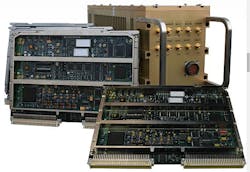Navy continues buying radar-spoofing electronic warfare (EW) equipment from Mercury Systems
LAKEHURST, N.J. – U.S. Navy airborne electronic warfare (EW) experts are continuing their support of radar-spoofingelectronic warfare (EW) technology from Mercury Systems Inc. that can fool enemy radar systems with false and deceptively moving targets.
Officials of the Naval Air Warfare Center Aircraft Division in Lakehurst, N.J., announced an $8.6 million contract Monday to the Mercury Defense Systems (MDS) subsidiary of Mercury Systems Inc. in Cypress, Calif., for 18 additional Type II Advanced Digital Radio Frequency Memories (DRFM) units.
The Navy ordered 28 DRFM units from Mercury in an April 2016 contract for $15.4 million, and ordered 14 Mercury DRFM units in a June 2015 contract for $7.6 million. Previous to that, Mercury won a $2.6 million DRFM order in October 2014, and a $1.5 million Navy order for this technology in June 2014.
This order is for a U.S. Air Force Small Business Innovative Research (SBIR) project called Advanced Techniques for Digital Radio Frequency Memories.
Related: Programmable radar and adaptive electronic warfare take center stage
DRFM technology has several unique features for covert EW applications. First, it provides coherent time delay of RF signals in applications like radar and electronic warfare. It also produces coherent-deception jamming to an enemy radar system by replaying a captured radar pulse with a small delay, which makes the target appear to move.
DRFM also can modulate captured pulse data in amplitude, frequency, and phase to provide other affects. A Doppler shift correlates range and range rate trackers in the radar. DRFM also can replay captured radar pulses many times to fool the radar into perceiving many targets.
Small packages, fast response, and large volumes of low-latency compute power define modern DRFM evolution, Mercury officials say. The company's latest DRFM technology produces modules as thin as 0.44 inches, and capitalizes on direct digital synthesizer (DDS) local oscillator (LO) technology.
DDS technology delivers sub-microsecond tuning speeds over a wide bandwidth, while advanced circuit design and simulation helps reduce spurious, inter-module, and phase noise.
Related: COTS invades radar signal
Mercury engineers are continuing their technology advancements to the company's DRFM technology to keep pace with evolving threats and ensure that U.S. aircrews are trained realistically for combat, Mercury officials say.
Electronic countermeasures techniques for pipeline, stretched pulse including synthetic continuous wave, and multiple false target modes are defined through the device's user interface.
On this DRFM order, Mercury will do the work in Cypress, Calif., and should be finished by December 2018. For more information contact Mercury Defense Systems online at www.mrcy.com/defense_systems, or the Naval Air Warfare Center Aircraft Division-Lakehurst at www.navair.navy.mil.
Learn more: search the Aerospace & Defense Buyer's Guide for companies, new products, press releases, and videos

